The University of Macau (UM) has focused on the development of ocean science in recent years. UM has established research centres, academic departments, and degree programmes to promote the cultivation of marine talent and innovative research and to support the development of Macao. Currently, UM’s research team is expanding frontier research in areas such as the prevention and control of water body pollution in the coastal waters of the Guangdong-Hong Kong-Macao Greater Bay Area (GBA), marine disasters, and the safety of coastal cities. UM researchers also collaborate with universities and research institutes at home and abroad to create an international platform for cooperation in ocean science and technology.
Emphasising ocean science development
The sustainable development of the oceans is a globally shared concern. In recent years, UM has focused on research and collaboration in ocean science, making regional ocean research one of the three key development directions in its research layout. UM established the Centre for Regional Oceans in 2020, followed by the launch of the Department of Ocean Science and Technology and related postgraduate programmes in 2022. These initiatives aim to promote the cultivation of top-notch professionals and research development in ocean science, as well as to meet the needs of Macao. In 2022, the China-Portuguese Speaking Countries Ocean Research Alliance initiated by UM was also inaugurated, promoting science and technology cooperation and talent cultivation between China and Portuguese-speaking countries in the field of ocean science.
In 2015, the State Council approved the demarcation of 85 square kilometres of waters for Macao, bringing new opportunities for the spatial development of the city and for ocean research. ‘As a coastal city, Macao has launched many large-scale marine projects in recent years, such as land reclamation and the construction of cross-sea bridges,’ says Xu Jie, head of the Department of Ocean Science and Technology and interim director of the Centre for Regional Oceans at UM. He continues, ‘Ocean research can provide technological support for large-scale marine engineering projects, reduce the impact of the projects on the nearby marine ecological environment, and ensure sustainable development and utilisation of Macao’s sea areas.’
Safeguarding marine ecology in the GBA with a ‘land-sea’ approach
As the waters of the GBA are interconnected, the protection of Macao’s marine ecology is inseparable from the study of surrounding sea areas. By focusing on marine dynamics and the transport of substances in the waters surrounding Macao, UM’s research team has developed the ‘Three-Dimensional High-Resolution Simulation System for Estuary-Shelf in the Greater Bay Area’. According to Prof Xu, estuaries and shelves are transitional zones between rivers and oceans, acting as the main pathways for pollutants to pass from land to sea. This system helps researchers understand the sources of marine pollutants and explore their movements as well as the scale of their potential impact.’
The team’s research centers on the impact of nitrogen and phosphorus pollutants on marine ecology, as well as pollution prevention and control measures. Prof Xu indicates that nitrogen and phosphorus pollutants are transported through rivers from upstream in the Pearl River to its downstream and to the sea areas of the GBA, which will lead to eutrophication of the water bodies and which will cause problems including red tides and oxygen depletion in water bodies. He points out, ‘To solve the problem of eutrophication in the waters in the GBA, it is necessary to adopt an approach that considers both the land and the sea. It involves not only effective pollution control measures in downstream areas, but also proper control of nitrogen and phosphorus pollutant emissions in upstream areas. Collaboration among the cities in the GBA has become essential.’
Developing innovative marine technologies
To further monitor the motions and transformation of marine pollutants, the UM team has developed innovative marine technologies, including ocean observation equipment and marine communication technologies, which have improved the monitoring and collection of data, thus supporting the development of frontier research projects. In addition, UM’s autonomous surface craft Delmac and intelligent underwater vehicle Orvis — projects both initiated by UM — were showcased at a parallel session at the Third Conference of the International Science, Technology and Innovation Forum of Boao Forum for Asia in September 2023, drawing attention from experts at home and abroad. These two marine robots enable accurate tracking, patrolling, and the collection and monitoring of high-resolution data. They can provide great help when research teams conduct offshore surveys, thus accelerating UM’s research progress in ocean science.
Prof Xu says, ‘By developing advanced marine technologies, our research team can obtain better data on the physical, chemical, and biological characteristics of nearshore waters, thus advancing frontier research in ocean science.’
Enhancing urban disaster resilience
UM’s research team has conducted simulation and risk assessment research on marine disasters such as typhoons and floods, aiming to reduce the impact of these disasters on coastal cities and architecture. Among them, the team formed by Prof Yuen Ka-Veng, Distinguished Professor in the Department of Civil and Environmental Engineering and co-director of the Guangdong-Hong Kong-Macao Joint Laboratory for Smart Cities, and his PhD student Wang Sheng developed a highly efficient identification model based on a feature fusion-based broad learning system last year. The model can forecast typhoons at an average of 13.5 hours before their formations, with nearly 90 per cent accuracy. Additionally, they have utilised remote sensing data about nearshore water levels to accurately assess the power of storm surges, providing early warnings for marine disaster classification and facilitating decision making.
The development of the GBA has seen increase in infrastructure projects such as cross-sea bridges and tunnels, which, however, is also accompanied by challenges in operation safety, particularly during typhoons. Prof Yuen’s team developed the Civil Infrastructure Health Monitoring Platform, which is capable of carrying out intelligent analysis of massive monitoring data in complex environments and under coupled loads. The platform makes it possible to do real-time monitoring of key indicators for health of structures and to predict the health conditions of infrastructures.
Prof Yuen continues, ‘Intelligent and automated means enable early detection of structural damage, extent of damage, and location of damage in infrastructures, which gains us more time to evacuate and reinforce the damaged buildings. We will continue to accumulate practical experience in disaster prevention in coastal cities and monitoring the health of building structures.’
Building a research platform for cooperation
UM remains committed to advancing ocean science through talent cultivation and research innovation. Prof Xu concludes, ‘We actively expand technological innovation in ocean research, striving to facilitate Macao’s integration with the GBA and the national ocean science and technology innovation platform. At the same time, we will continue to leverage the advantages of the China-Portuguese Speaking Countries Ocean Research Alliance to gather the research strengths and resource advantages of its members in the field of ocean science, so as to establish an international platform for cooperation in ocean science and technology.’
Text: Kelvin U
English Translation: Bess Che
Photo: the Editorial Board
Source: My UM ISSUE 127
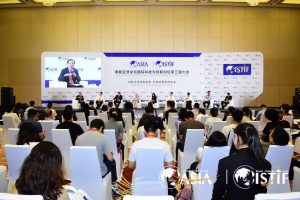
UM holds parallel session at the International Science, Technology and Innovation Forum of Boao Forum for Asia held in ZhuhaiUM
在博鰲亞洲論壇上介紹大學自主研發的智能海洋機器人-300x225.jpg)
UM Rector Yonghua Song (centre) introduces a smart marine robot developed by UM
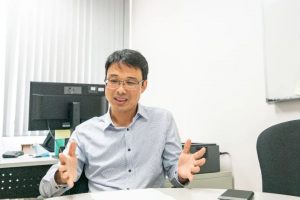
Prof Xu Jie
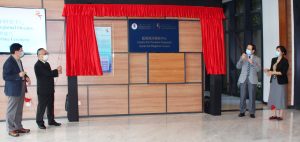
UM established the Centre for Regional Oceans in 2020
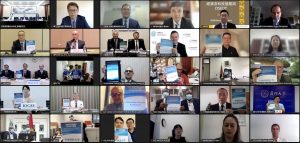
UM launched the Department of Ocean Science and Technology in 2022
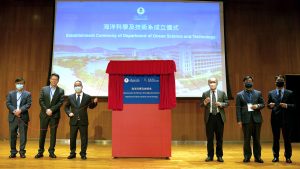
The China-Portuguese Speaking Countries Ocean Research Alliance initiated by UM was also inaugurated in 2022.
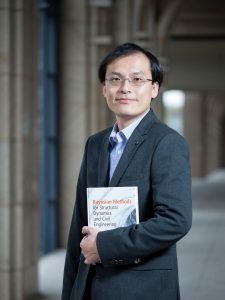
Prof Yuen Ka-Veng
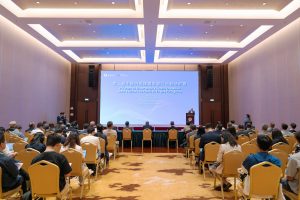
UM held the 2nd China and Portuguese-speaking Countries Ocean Research and Education Symposium in October 2023.
